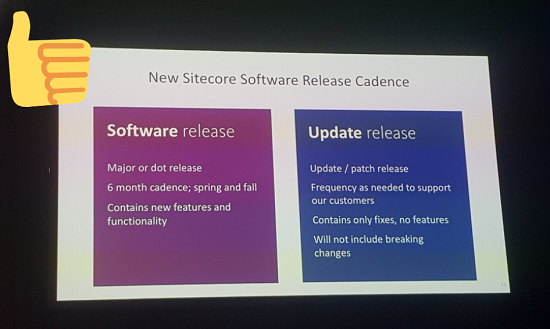Fellow Sitecore MVP Dan Persson and I were invited to speak about User Journeys at the 2018 Sitecore User Group Conference in Berlin. SUGCON, for short, is a developer-focused convention which focuses on useful applications of Sitecore, new ideas for extensions, and a vision of where the product is going. For the first time, SUGCON contained a digital strategy track, which included our talk, Journey Mapping in Real Life. (More on that soon.)
There were three big insights that we came away with from SUGCON:
1. Sitecore is going to standardize its software releases to 2x a year
Sitecore opened with a vision of how the software release cycle was going to change. Previously, Sitecore has managed releases around events (like their Sitecore Symposium) or based on feature completion. This always created a problem – what version should you use to build a project?
By standardizing the release cycle, we can now plan around new versions every year, which simplifies the upgrade process. Likewise, Sitecore is creating distinct Software release vs. Update releases, best explained by this handy chart:
This creates a rational, consistent approach to planning a Sitecore installation. Developers were quite relieved by this announcement.
2. Increased emphasis on scalable, object-oriented intent
Developers are interested in artificial intelligence and voice extensions, e.g. Alexa skills. Both talks were on the main stage and they contained not only innovative features, but also require innovative technology.
Technical development in these extensions requires breaking down user interactions into smaller components. For AI, the demo focused on artificial intelligence assisting with content tagging – take this list of top 100 terms, review 30,000 items, and apply the appropriate set of 100 items to this page. What this requires is changing the approach to building the curated list of items, building the rules of running the analysis, and then letting the system apply that logic to the data.
For voice, developing an Alexa skill requires you break down the intent – what the user said – and the action – what you want them to do. Thus, over time, you can create more intents to trigger the same action. You can also leverage items like AlexaCore which provides common tasks to help you get started and/or reduce the “grunt” work of programming.
Second, these technologies depend on scalable, cloud-based architecture. As you create units of work – the AI analysis, the volume of voice searches happening at any given time – these units consume resources on demand by necessity, thus they are linked to AWS (Amazon owns both Alexa and AWS) or Azure.
It’s cool twice over for developers.
Does it actually work? Well, the business value is emerging, but it is cutting edge technology. The application of these extensions within Sitecore is still in the nascent phase, but perhaps by Sitecore Symposium this fall, we’ll be able to see some real value.
3. Everyone is struggling with journey orchestration
My biggest personal takeaway ties into our talk: everyone is struggling with making journeys work from strategic idea to palpable technical reality.
One of the first keynotes was a trip through “Sitecoreland” which imagined a real-world theme park that integrated content, mobile push technology, real-time coupons, etc. Since it was an applied technology talk, it didn’t have to deal with the limits of user comfort with such ideas. The presenters amusingly presumed what park goers would enjoy.
In real-life though, you need a model to connect the organization’s needs to the end-users’ desires. And you need a way to safeguard the experience from becoming disruptive. The current answer of, “you can have people opt-out,” is really a reflection of privacy laws, such as GDPR. But while that opt-out limits data collection, it does not necessarily impact analysis done independently.
When you factor in the rate of change, with AI appending other sets of data about a user – say propensity data collected from a third party – the need to understand the complete experience becomes paramount.
Honestly, Dan and I thought we might get 20 people in our talk – we got closer to 100. It is clear to me while the technical ability is there, the organizational structures of departments, activities, and even culture dampen the realization of that potential.
So, for those who didn’t get to Berlin this time, we’re going to run our talk as a webinar later this summer. If you want to know when, sign up for our newsletter!


